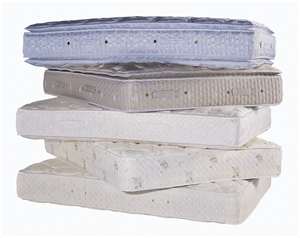If you’re going to be using a standard double/full size mattress on your double/full size antique iron bed, you’re not going to come across any difficulties at all. Antique double sizes and modern day double sizes are exactly the same. 
One thing you should know…..old iron beds have side rails that were made particularly for each individual bed. They are not interchangeable. Some of the foundries back in the 1800’s that built beds, made their side rails so they seem to be upside down, without an “L” shaped channel . That was because the spring units that were built for those beds didn’t set inside the angle iron side rail…… they “clipped” to the side rail with an attachment to secure them in place. So if you get a set of what we call “flat top” side rails with your bed, don’t think you got the improper ones or that they were made incorrectly. As long as they fit securely in the cast iron “hitch” that was poured around the side tube, you’ll be fine.
You’re going to need to have 3 or 4 bed slats cut to hold your box spring and mattress on your bed. These bed slats need to be wooden 2″ x 4″s. They fit the best on the old 1 1/2″ angle iron side rails. Now if you have the “L” shaped side rails, you’ll be able to merely place these bed slats inside the side rail. But….. if your side rails are “flat top” side rails, you’re going to need to have holes drilled through the side rail and a corresponding hole drilled through the 2″ x 4″ which is going to be under the side rail. Use a 1/4″ drill bit for the drilling the hole. The use 1/4 x 20 bolts, washers and nuts to attach the 2″ x 4″ in place under the side rail. Now you can position your box spring and mattress on top of your bed.
If you’d like to use a contemporary Queen Size mattress on your double size bed……. no problem. As you may already know, the variation in width between the antique double size bed and the contemporary queen is negligible…. It’s only a couple of inches on both sides. So a width conversion isn’t essential like that with a king, which we’ll clarify next. The way we accommodate the old double to hold the queen mattress is by welding the side rails, that attach the headboard and foot board together, lengthwise, longer by 5″. Once put together, the box spring and mattress will set on top of the side rails and extend over a couple of inches. Once your bed is correctly dressed, that width difference is not noticeable. Any welder can make this adjustment to your side rails. The 2″ x 4″ wooden bed slats will be the same, with one exception. We propose, because of the extra size and weight of the queen size mattress that small 2″ x 4″ wooden supports be nailed under the wooden bed slats. You can measure for these short supports by measuring the length from the bottom of the wooden bed slat to the floor. There should be two supports per bed slat. They should be nailed in place and placed about 12″ in from the side. This will give you plenty of support to your bed and you won’t stub your toe when standing along side it.
As we know, the biggest size of most bed being made back in the early 1800’s was a double size. So when someone wants a king size, the original double size will need to be transformed into a king size. That’s done by cutting the bed apart in integral places and adding extra tubing to increase the width of the headboard and foot board. If done correctly, molds of the unique castings will need to be taken, so when added vertical rods are required, the foundry will be able to pour those needed castings. This will insure that when a bed is transformed to a bed to king size, it’s being done in the same manner in which the bed was initially put together close to 200 years ago. King conversions are not an easy process. It takes a fabricator who is use to taking molds, pouring molds, welding added tubing and rods in such a manner that it can’t be detected and the move from old tubing to new is undetectable. Be sure the person undertaking this is well versed in these areas.
Any modern day size mattress can be utilized on one of our bedframes with these simple adjustments.






